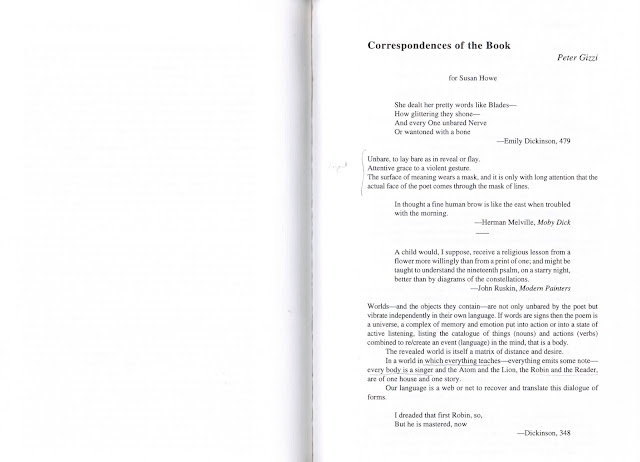On Coherence and Correspondence: Peter Gizzi.
 In the blurb to A Poetics of Criticism, we are told that
the essays collected within, including ‘Correspondences of the Book’, ‘perform
the compositional mutation of enacting as they tell... explore the fluidities
and possibilities within a poetics of criticism’. I must say I’m always suspicious of the language of enacting and performance,
not out of some conservative grumpiness but rather the opposite: a worry that
latent in the enactment-telling distinction we actually find form and content
being replayed, when at its most powerful ‘performance’ should be able to short
circuit such a reductive approach. And yet, reading ‘Correspondences of the
Book’, I find myself in the slightly invidious situation of asking at certain
moments, ‘what is the main claim?’, or ‘what is the central argument?’. Maybe
this is a hangover from endless weeks of marking student essays, but I think it
might point to something more interesting happening in Gizzi’s essay (if
‘essay’ it is). As it strikes me, the essay uses the declarative sentence, the
assertive judgment, in such a way as to imply a ‘content’, but sets up
correspondences between these declarative sentences which will resist their
cohering into an ‘argument’. The sentences claim something, certainly, claim a
good many things, but they do not thereby become ‘claims’. The essay demands
that we read within this double-bind.
In the blurb to A Poetics of Criticism, we are told that
the essays collected within, including ‘Correspondences of the Book’, ‘perform
the compositional mutation of enacting as they tell... explore the fluidities
and possibilities within a poetics of criticism’. I must say I’m always suspicious of the language of enacting and performance,
not out of some conservative grumpiness but rather the opposite: a worry that
latent in the enactment-telling distinction we actually find form and content
being replayed, when at its most powerful ‘performance’ should be able to short
circuit such a reductive approach. And yet, reading ‘Correspondences of the
Book’, I find myself in the slightly invidious situation of asking at certain
moments, ‘what is the main claim?’, or ‘what is the central argument?’. Maybe
this is a hangover from endless weeks of marking student essays, but I think it
might point to something more interesting happening in Gizzi’s essay (if
‘essay’ it is). As it strikes me, the essay uses the declarative sentence, the
assertive judgment, in such a way as to imply a ‘content’, but sets up
correspondences between these declarative sentences which will resist their
cohering into an ‘argument’. The sentences claim something, certainly, claim a
good many things, but they do not thereby become ‘claims’. The essay demands
that we read within this double-bind.
And
so, the question I wish to pose of this essay is the following: in what ways
does this essay cohere? What kind of coherence is at issue?
Firstly,
we can note two apparently conflicting assertions on coherence, given in close
proximity:
The true
test of poetry is in its ability to endure and cohere in time (180).
Do not try
to make it all cohere (181).
There is another
disjuncture in these two assertions: both come after a citation, the first from
Jack Spicer, the second from John Ruskin. Yet if the latter is paraphrase, the
former does not, at least at first, bear any obvious relation to the Spicer
quote: To make things visible rather than
to make pictures of them (phantasia non imaginari). If this is to be a claim
about coherence in time rather than about making-see versus representing (lamp
versus mirror in Abrams’s famous distinction) then sotto voce the correspondence of quote and paraphrase demands us to
surmise that making-visible, even visibility itself, are temporally
conditioned.
Perhaps
a key word here is that almost inconspicuous ‘all’: the coherence of poetry is
not a totalising coherence. Again, it strikes me that what is at issue is time:
to make ‘all’ cohere will not allow for temporal change; coherence must
‘endure’, rather than impose itself as a single moment imposes itself over
time.
But
does this insight into time itself, as it were, endure throughout the essay?
What I’ve identified here, somewhat tentatively, is a thinking of
‘in-time-ness’: coherence is always temporal. Yet when Gizzi speaks of the
‘real’, he suggests this lies outside
time. Here I see a series of associative moves which I suspect come from
Lévinas. We start with the ‘image’ (how does this relate the ‘picture’ that
Spicer denigrates for poetic phantasias?),
‘which is always the image of the face—our own and those of our masters—[and]
remains broken and separate from ourselves, yet intact over time’. This
sentence, or conjunction of sentences, points in far more directions than I can
pursue now (‘our masters’ not only indicating a troubling presence of political
authority but also relating back to the mastery of Dickinson’s robin, and
setting the two into correspondence; the disjunction of the face meaning we are
always outside ourselves, even in that marker of our identity—the face as point
of contact and entanglement of inside and outside). My question is the
following: how does ‘remain[] … intact over time’ relate to ‘endure and cohere
within time’? This is less a question of verbs (remain intact versus endure and
cohere), than of prepositions: ‘over’ versus ‘within’. The former points to an
outside of time which the latter will not. Lines later we find this train of
thought developed:
Here the real or the face of
the other—like the sun—is too much to bear. It must first be refracted inwardly
to be recorded or translated into a site of writing in order to be seen or
witnessed in time (183).
Here I am
reminded not only of Lévinas, but Kant’s account of the noumenon, which lies outside of time, and is what is truly real,
but which we never experience except within time (our a priori intuition). Or perhaps, given its unbearable brightness,
we can think of Plato’s ‘Cave’ allegory, where we must look at shadows because
the pure ‘idea’ is too blinding (remember also the visual trope of eidos, image). So maybe the coherence of
poetry in time is a function of
writing itself, which is a refraction into
time?
This
then refers back to the essay’s provocative opening assertion: ‘The surface of
meaning wears a mask, and it is only with long attention that the actual face
of the poet comes through the mask of lines’ (179). Does this mean that we, as
readers and critics, are ultimately looking through
the poem, searching for the poet behind
the lines? Is this akin to the ‘real face’ which we can only see ‘refracted’ in
writing and time? Of Dickinson, Gizzi says, she ‘transforms her language to
reveal her more subtle mind. Her ability is to make her language become her
feeling mind’ (181). Again, the surface of meaning wears a mask, and that mask
is language. And behind language lies mind. Yet at the same time, we see this
mask merge into the face behind it, which must trouble the surface-depth
opposition out of which it is first articulated. Because here language is not
the mask of mind but the mind—and the mind is no longer simply the mind, but a
‘feeling mind’. So Dickinson’s language in fact transforms the parameters of
what mind is.
There
are many other things to say of this essay, and the web or constellation of
correspondences it sets in train: in particular the different vectors pursued
by ‘correspondence’ itself: epistolary and epistemological, as well as its echo
of Baudelaire’s forêts de symboles.
And if I have focused on its reflection on time, then we also find running
alongside this a dense working of tropes of space, place, distance, and the
body. In particular, that if writing is a refraction into time, it is also the
filling of a void between self and other, a spatial refraction. And finally,
that paradox by which such refraction (also called ‘to displace an object into
art) is the only means by which one might encounter ‘our first light when we were the things themselves’.
But to finish I want to return to the question of
enactment. Gizzi’s essay is not simply a reflection on correspondences, but an
enactment of correspondences, and
which coheres not as a system (even if I have tried to tease out a latent
epistemology within it) but as it enacts these correspondences. On the one
hand, the pronouncements on surface, on the real, on the mind—all these imply
that enactment is a surface effect, a process, which refracts the real but does
not constitute it. On the other, there are certain cruxes where language does
become transformative, where its enactment will dissolve the conceptual boundaries
within which it is supposed to function. Is this tension irresolvable—that is,
does a criticism of enacting correspondences live within this tension? Or is
the ultimately of criticism-as-enactment to move off from this tension and
dissolve the oppositions—surface/depth, time/real, image/making-seen—themselves,
and find an anterior point of coherence?










